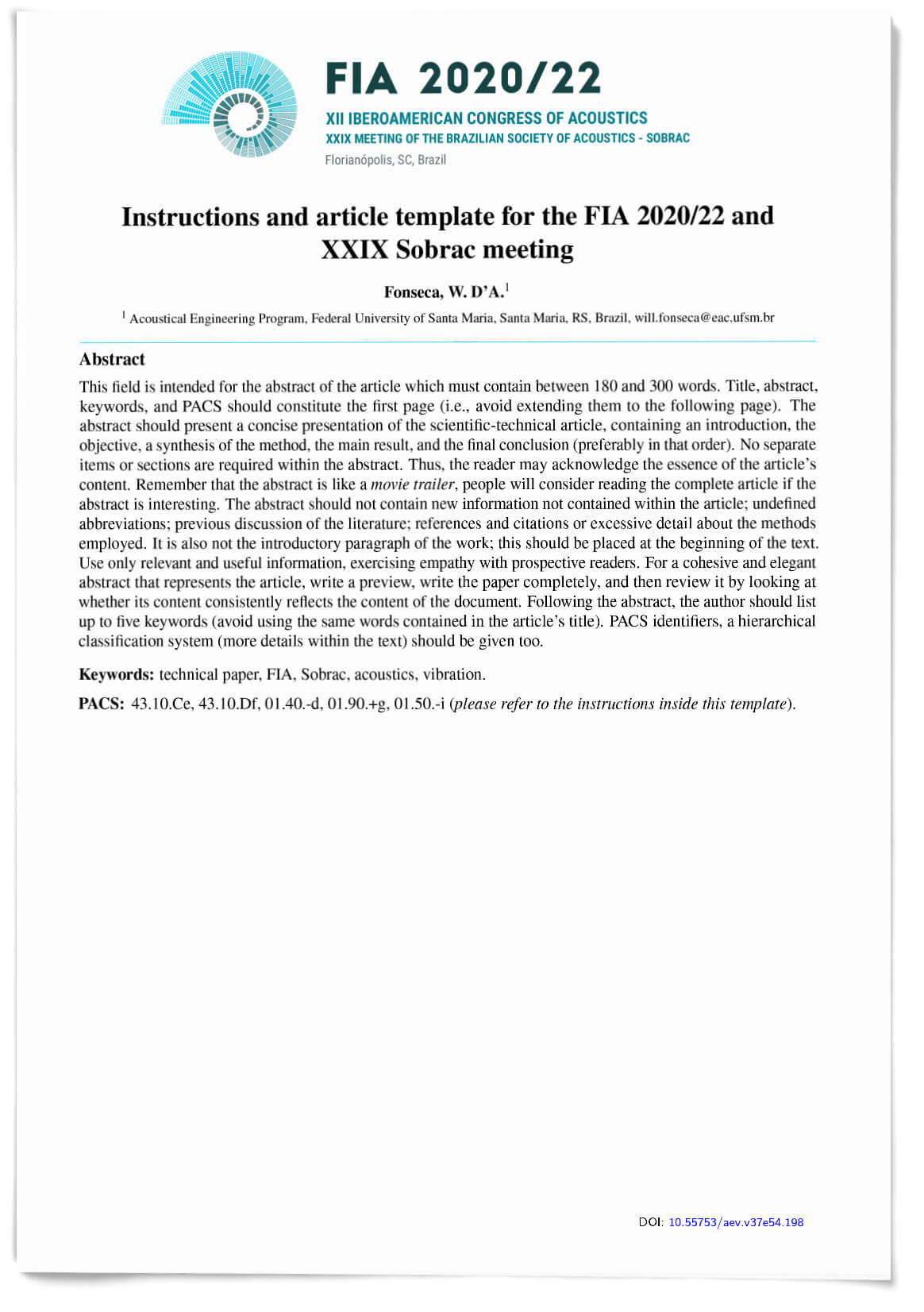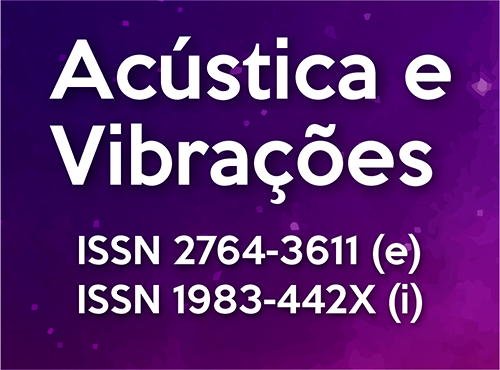Instructions and article template for the FIA 2020/22 and XXIX Sobrac meeting
DOI:
https://doi.org/10.55753/aev.v37e54.198Keywords:
technical paper, FIA, Sobrac, acoustics, vibrationAbstract
This field is intended for the abstract of the article which must contain between 180 and 300 words. The items resumo, palavras-chave, PACS, title, abstract, and keywords should constitute the first page (i.e., avoid extending them to the following page). The abstract should present a concise presentation of the scientific-technical article, containing an introduction, the objective, a synthesis of the methodology, the main result, and the final conclusion (preferably in that order). No separate items or sections are required within the abstract. Thus, the reader may acknowledge the essence of the article content. Remember that the abstract is like a movie trailer, people will consider reading the complete article if the abstract is interesting. The abstract should not contain new information not contained within the article; undefined abbreviations; previous discussion of another literature; references and citations or excessive detail about the methods employed. It is also not the introductory paragraph of the work; this should be placed at the beginning of the text. Use only relevant and useful information, exercising empathy with prospective readers. For a cohesive and elegant abstract that represents the article, write a preview, write the paper completely, and then review it by looking at whether its content consistently reflects the content of the document. Following the abstract, the author should list up to five keywords (avoid using the same words contained in the article’s title). After this step, there are also the PACS, which are a hierarchical classification system (more details within the text) and, finally, title, abstract, and keywords in English (PACS are only put after resumo in Portuguese contributions).
References
William D’A. Fonseca. Beamforming Considering Acoustic Diffraction over Cylindrical Surfaces (Original: Beamforming considerando difração acústica em superfícies cilíndricas). PhD thesis, Federal University of Santa Catarina, Florianópolis, SC, Brazil, 2013. URL http://www.bu.ufsc.br/teses/PEMC1445-T.pdf. ISBN 978-8591677405.
Paulo H. Mareze, Guilherme Copetti, Eric Brandão, William D’A. Fonseca, Fernanda Dresch, and Luciano P. Specht. Modeling the acoustic absorption of porous asphalt layers (Original: Modelagem da absorção acústica de camadas porosas asfálticas). In XXVII Meeting of the Brazilian Society of Acoustics (Sobrac 2017), Brasília, DF, Brazil, 2017. URL https://bit.ly/Modelagem-da-absorcao-acustica-de-camadas-porosas-asfalticas.
Eric Brandão. Room Acoustics: Design and Modeling (Original: Acústica de Salas: Projeto e Modelagem). Blucher, São Paulo, SP, Brazil, 1 edition, 2016. ISBN 978-8521210061.
Márcio H. A. Gomes, Paulo R. O. Bonifacio, Mário O. M. Carvalho, and Hilbeth P. Azikri. Vibro acoustic method for non destructive test of composite sandwich structures. Applied Mechanics and Materials, 751:153–158, 2015. ISSN 1662-7482. doi: 10.4028/www.scientific.net/AMM.751.153. DOI: https://doi.org/10.4028/www.scientific.net/AMM.751.153
Alan Oppenheim, A. Simon Willsky, and S. Hamid Nawab. Signals and Systems. Prentice Hall, River, NJ, USA, 2 edition, 1996. ISBN 978-9572181423.
Swen Müller and Paulo Massarani. Transfer-function measurement with sweeps. Journal of the Audio Engineering Society, 49(6):443–471, 2001. ISSN 1549-4950. URL http://www.aes.org/e-lib/browse.cfm?elib=10189.
Paulo H. Mareze, Eric Brandão, William D’A. Fonseca, Olavo M. Silva, and Arcanjo Lenzi. Modeling of acoustic porous material absorber using rigid multiple micro-ducts network: Validation of the proposed model. Journal of Sound and Vibration, 443:376 – 396, 2019. ISSN 0022-460X. doi: 10.1016/j.jsv.2018.11.036. DOI: https://doi.org/10.1016/j.jsv.2018.11.036
Joice Borges, Fernanda Pacheco, Bernardo Tutikian, and Maria Fernanda Oliveira. An experimental study on the use of waste aggregate for acoustic attenuation: EVA and rice husk composites for impact noise reduction. Construction and Building Materials, 161:501–508, 2018. ISSN 0950-0618. doi: 10.1016/j.conbuildmat.2017.11.078. DOI: https://doi.org/10.1016/j.conbuildmat.2017.11.078
João Paulo Ristow, Samuel Pinson, William D’A. Fonseca, and Julio Cordioli. Using the Kirchhoff-Helmholtz Integral to simulate multi-beam sonar data (Original: Utilização da Integral de Kirchhoff-Helmholtz para simulação de dados de sonar de múltiplos feixes). Acústica e Vibrações, 31(48):5–18, 2016. ISSN 1983-442X. doi: 10.55753/aev.v31e48.98.

Published
How to Cite
Issue
Section
License
Copyright (c) 2022 Acoustics and Vibrations (Acústica e Vibrações)

This work is licensed under a Creative Commons Attribution-NonCommercial-ShareAlike 4.0 International License.




